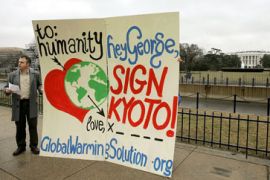Q&A: The Kyoto Protocol
UN conference in Bali aims to establish a successor to the 1997 agreement.

 |
| The US has yet to sign up to the emissions targets laid out in the Kyoto Protocol [GALLO/GETTY] |
The UN’s climate change conference in Bali aims to unite rich and poor nations to fight global warming and could shape global climate change policy for years to come.
The main thrust of the conference will be to find a follow-on agreement to the Kyoto Protocol.
Keep reading
list of 4 itemsAfter the Hurricane
World’s coral reefs face global bleaching crisis
Why is Germany maintaining economic ties with China?
The Protocol is seen by some as the world’s best hope in the battled against climate change, while its critics have questioned its usefulness.
The problem will be finding a common formula that encompasses both developing nations, including China, and industrial nations.
So what is the Kyoto Protocol?
The protocol came out of a 1997 UN conference held in Kyoto, Japan, and is intended to reduce greenhouse gas emissions by developed countries to at least five per cent below 1990 levels by 2008-12.
A total of 174 nations have ratified the pact.
What are nations committed to?
The UNFCC divided countries into developed and developing nations. The Kyoto Protocol commits 36 developed nations to individual targets on limiting green house gasses.
|
Your Views |
|
Mohamed Hassan, Somalia |
Not all have the same commitments, the EU, for example, which negotiates as a bloc, has committed itself to reducing greenhouse gas emissions by at least 20 per cent by 2020 compared with 1990 levels.
If taken together, the limits would reduce overall emissions of six greenhouse gases from these countries by approximately 5 per cent below 1990 levels before 2012. A relatively small reduction.
What penalties are there for those who miss their targets?
Countries overshooting their targets in 2012 will have to make both the promised cuts and 30 per cent more in a second period from 2013.
But the UNFCC’s developing nations do not have legally binding targets to reduce their greenhouse gasses during the 2008-12 commitment period.
The Kyoto Protocol suggests that developed nations should take greater responsibility for global warming, but the absence of targets for developing nations is a major sticking point.
Most rich nations want developing countries to at least to brake the rise of their emissions.
George Bush, the US president, has said the agreement unfairly discriminates in favour of developing countries and would stifle US growth. He has refused to ratify the treaty.
So what is the US doing?
Bush has agreed on the need for cuts, but has refused to accept mandatory emissions targets.
Recently he quoted an Energy Department report that showed US emissions of carbon dioxide had declined by 1.5 per cent last year while the US economy grew.
Where do the developing countries stand?
Developing nations, including China and India, oppose measures that might impinge on their efforts to tackle poverty. China has said it will not accept binding emissions quotas and is opening new coal-fired power plants at the rate of more than one a week.
Brazil, meanwhile, says the developed nations should pay to help curb climate change by protecting tropical forests.
Brazil, a major ethanol producer, also criticises the US for its import duties on biofuels.
How will countries comply with the protocol?
The Kyoto Protocol sets up a number of mechanisms for reducing emissions, including a framework for carbon trading.
Trading mechanisms also exist outside of Kyoto. The EU set up a market in January 2005 under which about 12,000 factories and power stations are given carbon dioxide quotas. If they overshoot they can buy extra allowances in the market or pay a financial penalty; if they undershoot they can sell them.
Developed countries are also able to earn credits, known as the Clean Development Mechanism (CMD), to offset against their targets by funding clean technologies, such as solar power, in poorer countries.
Were there any climate agreements before Kyoto?
The UN Framework Convention on Climate Change (UNFCC) treaty came about in 1992 when governments at a so-called Earth Summit in Rio de Janeiro agreed to tackle climate change with non-binding targets. Kyoto is the follow-up.
Governments say they need at least two years to ensure a smooth transition beyond Kyoto, which expires in 2012. The talks in Bali hope to reach some agreement on what comes next.